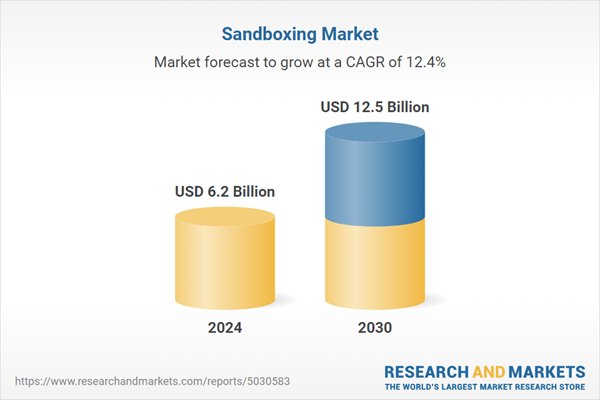The global market for Sandboxing was valued at US$6.2 Billion in 2024 and is projected to reach US$12.5 Billion by 2030, growing at a CAGR of 12.4% from 2024 to 2030. This comprehensive report provides an in-depth analysis of market trends, drivers, and forecasts, helping you make informed business decisions. The report includes the most recent global tariff developments and what they mean for your business.
Segments: Component (Solutions, Services); Vertical (Government & Defense, BFSI, IT & Telecom, Healthcare, Retail, Other Verticals).
Geographic Regions/Countries: World; United States; Canada; Japan; China; Europe (France; Germany; Italy; United Kingdom; and Rest of Europe); Asia-Pacific; Rest of World.
The analysts continuously track trade developments worldwide, drawing insights from leading global economists and over 200 industry and policy institutions, including think tanks, trade organizations, and national economic advisory bodies. This intelligence is integrated into forecasting models to provide timely, data-driven analysis of emerging risks and opportunities.
Global Sandboxing Market - Key Trends and Drivers Summarized
Sandboxing: Is It the Future of Cybersecurity in a Threat-Driven World?
Sandboxing is a cybersecurity technique that isolates potentially malicious files, applications, or code in a secure environment to analyze their behavior without risking damage to the host system. This approach is becoming increasingly important as cyber threats, such as zero-day exploits, ransomware, and advanced persistent threats (APTs), become more sophisticated and difficult to detect using traditional security measures. Sandboxing allows organizations to proactively detect and neutralize threats before they infiltrate critical systems or networks. The demand for sandboxing solutions is rising significantly in sectors such as finance, healthcare, government, and IT, where the security of sensitive data and compliance with regulations like GDPR, HIPAA, and PCI-DSS are paramount. By providing an additional layer of defense and enhancing threat detection capabilities, sandboxing is emerging as a critical tool in modern cybersecurity strategies.What Technological Innovations Are Enhancing the Effectiveness of Sandboxing?
Technological advancements are driving the evolution of sandboxing solutions, making them more effective, automated, and scalable. Modern sandboxing tools are increasingly leveraging artificial intelligence (AI) and machine learning (ML) to improve threat detection accuracy, speed, and adaptability. AI-driven sandboxing systems can analyze vast amounts of data in real-time, identify patterns, and predict potential threats, enabling faster and more accurate threat responses. The development of cloud-based sandboxing solutions is also gaining traction, offering organizations the flexibility to deploy and manage sandbox environments without the need for on-premises infrastructure. Additionally, the integration of sandboxing with endpoint detection and response (EDR) solutions, network security appliances, and unified threat management (UTM) systems is enhancing the overall cybersecurity posture of organizations by providing comprehensive threat protection and incident response capabilities.What Market Trends Are Shaping the Sandboxing Industry?
The sandboxing market is shaped by several key trends, including the rising frequency and complexity of cyber attacks, the shift towards cloud-based security solutions, and the increasing focus on real-time threat intelligence and automated incident response. As cyber threats become more sophisticated and targeted, organizations are increasingly turning to sandboxing solutions that can provide proactive threat detection and mitigation. The shift towards cloud-based security, driven by the need for scalability, flexibility, and cost-efficiency, is also fueling the demand for cloud-based sandboxing solutions that can protect virtual environments. The growing emphasis on real-time threat intelligence and automated incident response is encouraging the adoption of sandboxing solutions that offer seamless integration with threat intelligence platforms and provide actionable insights for faster threat remediation.What Are the Key Drivers of Growth in the Sandboxing Market?
The growth in the sandboxing market is driven by several factors, including technological advancements in AI and cloud-based solutions, increasing demand for advanced threat detection and protection, and the rising focus on regulatory compliance and data security. The integration of AI and machine learning capabilities in sandboxing solutions is enhancing their effectiveness in detecting and mitigating sophisticated threats, making them essential in sectors like finance, healthcare, and government. The shift towards cloud-based security solutions, which offer scalability, flexibility, and cost-efficiency, is expanding the market for cloud-based sandboxing tools. The increasing need for compliance with data protection regulations and the focus on enhancing incident response and threat intelligence capabilities are further driving the adoption of sandboxing solutions. Additionally, the growth of managed security service providers (MSSPs) and the integration of sandboxing with endpoint detection and response (EDR) and unified threat management (UTM) platforms are creating new opportunities for market growth and innovation.Report Scope
The report analyzes the Sandboxing market, presented in terms of units. The analysis covers the key segments and geographic regions outlined below.Segments: Component (Solutions, Services); Vertical (Government & Defense, BFSI, IT & Telecom, Healthcare, Retail, Other Verticals).
Geographic Regions/Countries: World; United States; Canada; Japan; China; Europe (France; Germany; Italy; United Kingdom; and Rest of Europe); Asia-Pacific; Rest of World.
Key Insights:
- Market Growth: Understand the significant growth trajectory of the Solutions segment, which is expected to reach US$7.9 Billion by 2030 with a CAGR of a 12.0%. The Services segment is also set to grow at 13.2% CAGR over the analysis period.
- Regional Analysis: Gain insights into the U.S. market, valued at $1.7 Billion in 2024, and China, forecasted to grow at an impressive 11.5% CAGR to reach $1.9 Billion by 2030. Discover growth trends in other key regions, including Japan, Canada, Germany, and the Asia-Pacific.
Why You Should Buy This Report:
- Detailed Market Analysis: Access a thorough analysis of the Global Sandboxing Market, covering all major geographic regions and market segments.
- Competitive Insights: Get an overview of the competitive landscape, including the market presence of major players across different geographies.
- Future Trends and Drivers: Understand the key trends and drivers shaping the future of the Global Sandboxing Market.
- Actionable Insights: Benefit from actionable insights that can help you identify new revenue opportunities and make strategic business decisions.
Key Questions Answered:
- How is the Global Sandboxing Market expected to evolve by 2030?
- What are the main drivers and restraints affecting the market?
- Which market segments will grow the most over the forecast period?
- How will market shares for different regions and segments change by 2030?
- Who are the leading players in the market, and what are their prospects?
Report Features:
- Comprehensive Market Data: Independent analysis of annual sales and market forecasts in US$ Million from 2024 to 2030.
- In-Depth Regional Analysis: Detailed insights into key markets, including the U.S., China, Japan, Canada, Europe, Asia-Pacific, Latin America, Middle East, and Africa.
- Company Profiles: Coverage of players such as Broadcom, Inc., Check Point Software Technologies Ltd., CloudShare, Codeyoung, Criterion Networks Inc. and more.
- Complimentary Updates: Receive free report updates for one year to keep you informed of the latest market developments.
Some of the 13 companies featured in this Sandboxing market report include:
- Broadcom, Inc.
- Check Point Software Technologies Ltd.
- CloudShare
- Codeyoung
- Criterion Networks Inc.
- Cybergenic
- Cynet Security Ltd
- Fortinet, Inc.
- Keen Games GmbH & Co., KG
- Palo Alto Networks, Inc.
Tariff Impact Analysis: Key Insights for 2025
Global tariff negotiations across 180+ countries are reshaping supply chains, costs, and competitiveness. This report reflects the latest developments as of April 2025 and incorporates forward-looking insights into the market outlook.The analysts continuously track trade developments worldwide, drawing insights from leading global economists and over 200 industry and policy institutions, including think tanks, trade organizations, and national economic advisory bodies. This intelligence is integrated into forecasting models to provide timely, data-driven analysis of emerging risks and opportunities.
What’s Included in This Edition:
- Tariff-adjusted market forecasts by region and segment
- Analysis of cost and supply chain implications by sourcing and trade exposure
- Strategic insights into geographic shifts
Buyers receive a free July 2025 update with:
- Finalized tariff impacts and new trade agreement effects
- Updated projections reflecting global sourcing and cost shifts
- Expanded country-specific coverage across the industry
Table of Contents
I. METHODOLOGYII. EXECUTIVE SUMMARY2. FOCUS ON SELECT PLAYERSIII. MARKET ANALYSISIV. COMPETITION
1. MARKET OVERVIEW
3. MARKET TRENDS & DRIVERS
4. GLOBAL MARKET PERSPECTIVE
UNITED STATES
CANADA
JAPAN
CHINA
EUROPE
FRANCE
GERMANY
ITALY
UNITED KINGDOM
REST OF EUROPE
ASIA-PACIFIC
REST OF WORLD
Companies Mentioned (Partial List)
A selection of companies mentioned in this report includes, but is not limited to:
- Broadcom, Inc.
- Check Point Software Technologies Ltd.
- CloudShare
- Codeyoung
- Criterion Networks Inc.
- Cybergenic
- Cynet Security Ltd
- Fortinet, Inc.
- Keen Games GmbH & Co., KG
- Palo Alto Networks, Inc.
Table Information
| Report Attribute | Details |
|---|---|
| No. of Pages | 259 |
| Published | April 2025 |
| Forecast Period | 2024 - 2030 |
| Estimated Market Value ( USD | $ 6.2 Billion |
| Forecasted Market Value ( USD | $ 12.5 Billion |
| Compound Annual Growth Rate | 12.4% |
| Regions Covered | Global |









